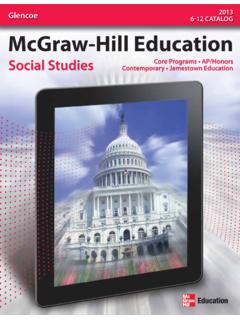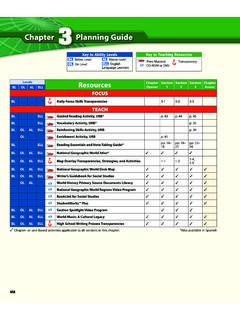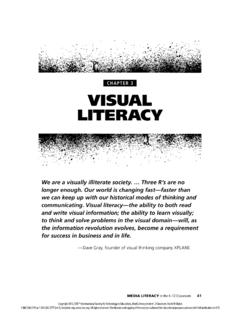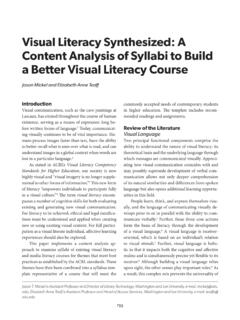Transcription of Teaching multiliteracies across the curriculum
1 Teaching multiliteraciesacross the curriculumChanging contexts of text andimage in classroom practiceLen UnsworthOpen University PressBuckingham PhiladelphiaOpen University PressCeltic Court22 BallmoorBuckinghamMK18 1 XWemail: wide web: Chestnut StreetPhiladelphia, PA 19106, USAF irst Published 2001 Copyright Len Unsworth, 2001 All rights reserved. Except for the quotation of short passages for the purpose of criticismand review, no part of this publication may be reproduced, stored in a retrieval system, ortransmitted, in any form or by any means, electronic, mechanical, photocopying, recordingor otherwise, without the prior written permission of the publisher or a licence from theCopyright Licensing Agency Limited. Details of such licences (for reprographic reproduction)may be obtained from the Copyright Licensing Agency Ltd of 90 Tottenham Court Road,London, W1P catalogue record of this book is available from the British LibraryISBN 0 335 20604 2 (pb) 0 335 20605 0 (hb)Library of Congress Cataloging-in-Publication DataUnsworth, multiliteracies across the curriculum : changing contexts of text and image inclassroom practice / Len bibliographical references and 0-335-20605-0 ISBN 0-335-20604-2 (pbk.)
2 1. visual literacy . 2. visual education. 3. Learning. I. 23 dc2100-052452 Typeset by Graphicraft Limited, Hong KongPrinted in Great Britain by Biddles Limited, Guildford and King s LynnContentsList of figuresviiiAcknowledgementsxiiIntroducti on1 Part IFraming perspectives51 Changing dimensions of school literacies7 Part IIFacilitating knowledge212 Learning about language as a resource for literacydevelopment233 Describing visual literacies714 Distinguishing the literacies of school science and humanities 1135 Exploring multimodal meaning-making in literature forchildren148 Part IIIC lassroom practicalities1816 Developing multiliteracies in the early school years1837 Developing multiliteracies in content area teaching2208 Teaching multiliteracies in the English classroom260 References283 Index296 Introduction 1 IntroductionCentral to the orientation of this book is a view of literacies.
3 Learning and Teaching ascompletely interconnected social processes. As the theoretical and research bases forthis position became more established in the 1980s and 1990s, some tertiary textbooks(Unsworth 1993d) dealt with the detailed practical classroom ramifications of thesetheoretical understandings about the social construction of literacies. While there is astrong and continuing consensus about the more socially responsible practices inliteracy pedagogy explicated at the time, the parameters of school literacies have beensignificantly extended with the rapid cultural and technological changes in literateforms of communication in recent years. Predominant among these are the growingimpact of images in an increasing range of texts and the shift from page to screen-basedliteracies.
4 Learning materials in school subject areas are changing, texts of popular cul-ture are being seen as important curriculum resources and traditional resources like chil-dren s literature are being influenced by intermodal comparisons and have been some useful publications dealing separately with some issues arisingfrom these changes. However there remains a need to address the bi-directional impactof research and practice from the perspectives of both beginning and experiencedclassroom teachers. Teachers are looking for a coherent and practical framework forclassroom work, which consolidates fundamental aspects of traditional literacy ped-agogy and also encompasses the multiliteracies competencies that children will need tonegotiate in the new millennium.
5 This book extends the trajectory of the 1993 editedwork, literacy Learning and Teaching : Language as Social Practice in the PrimarySchool (Unsworth 1993d), to attempt such an enterprise, focusing on primary andjunior secondary are three broad stages in the structure of this book as indicated in Figure perspectives in chapter 1 introduces sociocultural, semiotic and pedagogicperspectives on key issues in literacy learning and Teaching and emerging dimensionsof change. It addresses the theoretical and practical bases of contemporary literacypedagogy and foreshadows the subsequent chapters explorations of both consolida-tion and transformation in the development of a pedagogy of IntroductionFRAMINGPERSPECTIVESFACILITAT INGKNOWLEDGECLASSROOMPRACTICALITIES2 Learningaboutlanguageas a resourcefor literacydevelopment3 Describingvisualliteracies5 Exploringmultimodalmeaning-making inliteraturefor children1 Changingdimensions ofschool literacies6 Developingmultiliteraciesin the earlyschool years7 Developingmultiliteraciesin content areateaching8 Teachingmultiliteraciesin the Englishclassroom4 Distinguishingthe literaciesof schoolscience andhumanitiesFigure in the structure of this bookFacilitating knowledge
6 Deals with a number of areas of detailed technical knowledgeteachers need to have. chapter 2 is concerned with the grammatical, cohesive andgeneric structures of language. chapter 3 addresses the meaning-making structuresand features of images. chapter 4 delineates the distinctive textual forms and literatepractices of different school subject areas, including some of the ways in which com-puter technology mediates characteristic screen-based literacies. chapter 5 describes themultimodal meaning-making of literature for accounts of these areas of knowledge are important since most studentsand many teachers, due to the curriculum they experienced, have very little systematicknowledge about language structures. Nor have they studied visual semiotic frequently do not appreciate the distinctive literacies of subject areas and arenovices in the field of computer-based knowledge about how semiotic resources are deployed to make meanings in avariety of contexts facilitates teachers informed and effective intervention in children slearning.
7 Underlying the accounts of the meaning-making resources of language andimage in conventional and electronic modes across curriculum areas is the understand-ing that the ways in which these resources are deployed are mediated by the culturaland socioeconomic positioning of the participants. From this perspective the issue ofIntroduction 3critical social literacies is integrally linked to the actual descriptive accounts of themeaning-making practicalities shows how the knowledge of meaning-making systemsinforms the design and implementation of Teaching / learning activities in differentschool curriculum areas in classroom contexts from infancy to adolescence. chapter 6is concerned with Teaching children in the early years of schooling.
8 chapter 7 deals withthe development of multiliteracies in curriculum area Teaching and learning in theupper primary and junior secondary school, while chapter 8 focuses on work in theEnglish classroom at these levels. It is important that teachers have not only the soundunderstandings that will inform their practice at the particular school level of theircurrent Teaching , but that they also understand the differences and continuities ofteaching and learning literacies across primary and junior secondary schooling. As wellas articulating general principles and providing guidelines for the practical classroomteaching of multiliteracies , sample programs and detailed lesson material are importance of the bi-directionality of theory and practice in negotiating theteaching and learning of emerging multiliteracies is a major premise of the approachin this book.
9 The intention has been to provide sufficient detail to demonstrate theadvantages of engagement with this kind of theory practice orientation to classroomwork. Although selected key learning areas have been addressed in some detail, aconscious decision was made not to attempt the kind of panoramic survey that could dealonly superficially with the full range of learning areas. What is gained is a thoroughintroduction to informing theoretical understandings and detailed accounts of theirimpact on practical day to day planning of classroom activities. It is hoped that thisbook will stimulate critically constructive revision and renewal of what it advocatesas teachers and researchers together explore the kinds of interrelated theoretical andpractical understandings needed in negotiating changing contexts of text and imagein the social construction of multiliteracies in classroom R T IFraming perspectivesChanging dimensions of school literacies 7 OLD AND NEW LITERACIES: NEGOTIATING CHANGE,CONTINUITY AND COMPLEMENTARITYThe textual habitat, the textual environment which affects us and which we affect, hasexperienced remarkable changes in the twentieth century and will continue to do so inthe twenty-first century, as the students we teach grow to adulthood.
10 While many ofthe fundamentals of established, language-based literacy pedagogy will remain neces-sary, they are by no means sufficient for the development of the kinds of literacypractices that already characterize the continuously evolving information age of thenew millennium. We know that many young children have already functionally andcritically engaged with electronic and conventional format texts in ways which they donot encounter in their classrooms when they begin school (Green and Bigum 1993;Mackey 1994; Smith et al. 1996).Many instances can be cited from the professional literature and from everydayexperience of children intensely involved in multimodal textual practices outside theirschool experience, which are rarely reflected or acknowledged as part of school example, fifth grade students Max and James are avid users of the animationprogram Microsoft 3D Movie Maker.









